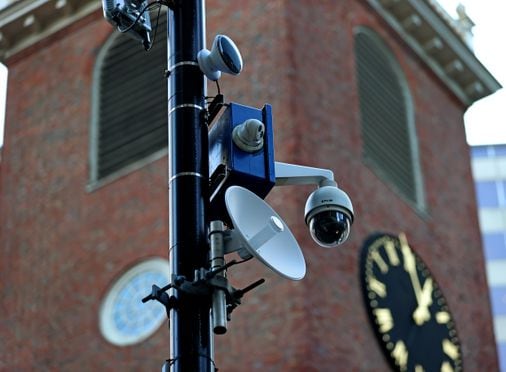Boston police have a variety of technologies in their arsenal of surveillance equipment: “Stingrays” or cell tower simulators used to covertly track cell phone locations; automatic license plate readers; and officer body cameras.
And the network of 1,300 cameras on light poles, road signs and buildings doesn’t include 400 operated by the city and the Boston Transportation Department. Boston Police have expanded their camera network since early 2023, when they operated fewer than 1,000 cameras.
These are highlights from Boston’s first-ever annual report on its use of surveillance technology, a new requirement under a 2021 city ordinance that gives the City Council the authority to acquire, fund, and approve the use of surveillance tools. The ordinance requires the submission of an annual report detailing the surveillance capabilities of all city agencies. The report will be sent to the City Council in early July, and the Council will hold a public hearing on the report on July 31, as well as discuss police use of gunshot detection technology.
More than 20 cities and towns across the country have passed similar surveillance ordinances in recent years, as technology like drones, facial recognition software and license plate readers have become increasingly available to local governments. Big cities like Seattle, Detroit, San Diego and Oakland have passed similar measures, while local areas like Cambridge, Lawrence and Somerville have passed similar measures.
Human rights groups that pushed for the 2021 ordinance welcomed the new transparency measures but added that there were information gaps in the report that needed to be filled.
“This is a good start,” said Cade Crockford, director of the Technology for Liberty Project at the ACLU of Massachusetts. “There’s still more missing. There’s a lot missing.”
For example, Crockford said Boston Public Schools reported spending $1.8 million last year on security cameras in its schools. The report said the schools would provide the footage to police in “immediate emergencies,” but would otherwise require a subpoena, warrant or court order.
But the school district has not disclosed how many security cameras it has or where they are located, nor has it provided details about how often it shares footage with law enforcement.
Additionally, in a section asking whether the technology violates the civil rights of vulnerable students, the district simply wrote “not applicable.” Crockford said the subject requires more depth, given that the public school system is disproportionately black. He also said police using school video footage to prosecute minor cases could exacerbate the school-to-prison dynamic.
“Schools are sensitive places,” Crockford said, “and students and their parents have a lot of privacy concerns.”
Meanwhile, police departments spent $753,000 on security cameras last year. There was one whistleblower complaint in 2023 alleging that Boston police officers misused camera footage, according to the report, but the nature of the allegation was not disclosed. That investigation is still ongoing.
A city spokesperson told the Globe that technology plays a “critical role” in protecting public safety in Boston.
“Each year the city looks forward to the opportunity to share how we are using technology across departments to keep residents and our community safe while upholding their right to privacy,” the spokesperson said in a statement.
The statement did not address questions about whether parts of the report were incomplete.
“The City remains committed to transparency, accountability and building trust with our residents to ensure Boston remains one of the safest cities in the nation,” the statement said.
As part of its report under the ordinance, the police department submitted a memo touting the importance of surveillance technology to public safety. The memo listed 44 incidents in which surveillance technology proved helpful, which the department described as a “representative sample” of its use of the technology.
These cases included the use of drones, video camera networks, license plate readers, police gang databases and the ShotSpotter gunfire detection system to assist in investigations of a variety of incidents, including drug busts, missing persons, robberies, shootings and stabbings.
In one high-profile case, Boston police used a surveillance camera network and a gang database to identify men who allegedly wounded eight people in a shootout at a Jove celebration in the Dorchester last year, according to the memo.
The report makes no mention of a notable ongoing controversy over surveillance, despite a requirement that the city report any community complaints or concerns about the technology. In the fall, the Supreme Court will hear a case alleging that undercover Boston police officers violated the state’s wiretapping law by secretly recording conversations with suspects without obtaining a warrant.
“This is a significant omission,” Crockford said.
Dan Glaun can be contacted at dan.glaun@globe.com. Follow.

